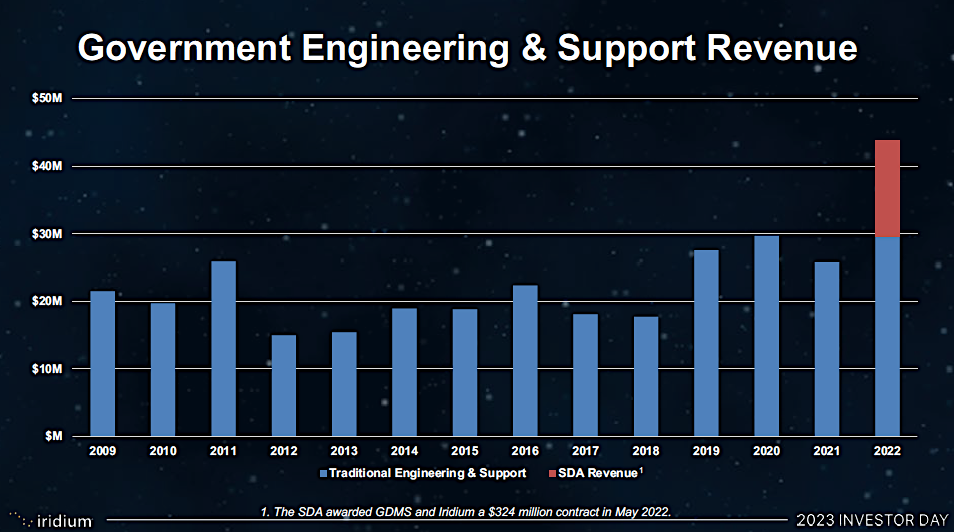Iridium’s forecast of 7.9% CAGR in service revenue to 2030 includes broader collaboration with US military
PARIS — Mobile satellite services service provider Iridium Communications’ forecast of an average 7.9% annual increase in service revenue in the next seven years, to reach $1 billion in 2030, includes substantial presumed growth in its U.S. military business.
The U.S. Defense Department has been an anchor customer for Iridium for over two decades and recent developments suggest it will play a key role in the revenue increase as Iridium finds new ways to further embed itself into U.S. military missions.
In Iridium’s Sept. 21 investor day, Scott Scheimreif, executive vice president for government programs, outlined how the U.S. military’s increasing use of commercial satellite systems alongside military assets.
Iridium and the Defense Department in 2014 signed a five-year, $400 million Enhanced Mobile Satellite Services (EMSS) contract — $80 million per year — allowing unlimited military use of Iridium services with communications landing at the dedicated DoD gateway station in Hawaii.
When that contract ended, it was replaced by a seven-year EMSS contract valued at $738.5 million — $105.5 million per year — ending in 2026.

Scott Scheimreif. Credit: LinkedIn
“The US Space Force looks at milsatcom as a total vision of government and commercial capacity,” Scheimreif said. “It’s no longer about milsatcom vs comsatcom, it’s satcom in general. We expect to see continued growth.”
Before, it was Iraq and Afghanistan that accounted for growth of military use of Iridium services. More recently, Ukraine has been an area of growth, even of the SpaceX Starlink broadband constellation has received most of the publicity about Ukrainian reliance on satcom.
We saw thousands of terminals being deployed in theatre by Starlink, and great geo-intelligence that helps Ukraine get a better picture,” Scheimreif said.
‘Flooding the Ukraine theatre with devices’
“At the same time, Iridium and our partners were flooding that theater with all sorts of communications equipment to provide situational awareness on the battlefield, as well as secure comms to support the Ukrainians.
“So now you are seeing commercial satcoms being used as part of the fight. That has driven a lot of close collaboration between industry and government as we look at this to continue,” he said.
Another new military market for Iridium is in operating constellations of military satellites using expertise developed over managing its own low-orbit constellation.

Credit: Iridium
In 2022 the U.S. Space Development Agency (SDA) selected General Dynamics and Iridium for a three-year contract to operate SDA’s Tranche 1 constellation for $162.95 million, with a four-year option of $161.6 million.
Iridium’s revenue over the seven-year period is expected to be $133 million over seven years. But its greater value is to put Iridium alongside SDA’s future network.
“Today we are in the process of standing up their operations centers in Grand Forks [North Dakota]; and Huntsville, Alabama. We will have folks in the seats actually flying their network as we take over from the vendors that were doing the launches.”
Iridium’s job will be to operate the constellation as a network. The prime contractors for the SDA network — SpaceX, Northrop Grumman, L3 Harris and York Space Systems — will manage their individual satellites.
In June, SDA announced it would be negotiate a sole-source contract with Iridium and General Dynamics for the agency’s Tranche 2 satellite constellation.
In September, the U.S. Space Force announced an indefinite-deliver, indefinite-quantity contract with some 19 companies, including Iridium, valued at up to $900 million over five years for “Proliferated Low Earth Orbit Satellite-Based Services.”
“We are pretty excited because our network operates today and they have been using it for 20-plus years,” Scheimreif said.
“This creates an opportunity introduce Certus [Iridium’s broadband product line] into the government. This and the completion of the installation of Certus at the government gateway, which we expect to have done by early 2025, allows us to bring Certus into that gateway.”
The U.S. Army’s Blue Force Tracking (BFT) program, now preparing its third-generation iteration of a network to prevent U.S. troops from firing on each other, has begun working with Iridium to integrate Iridium’s constellation into the current system, using L-band satellites in geostationary orbit operated by Inmarsat.
General Dynamics and L3 Harris will be building the Iridium-linked BFT terminals to be prepared to deploy them into 120,000 platforms starting in 2025, Scheimreif said. It’s one more program that will likely increase the value of the next multi-year EMSS contract, to be concluded in 2026 or 2027.